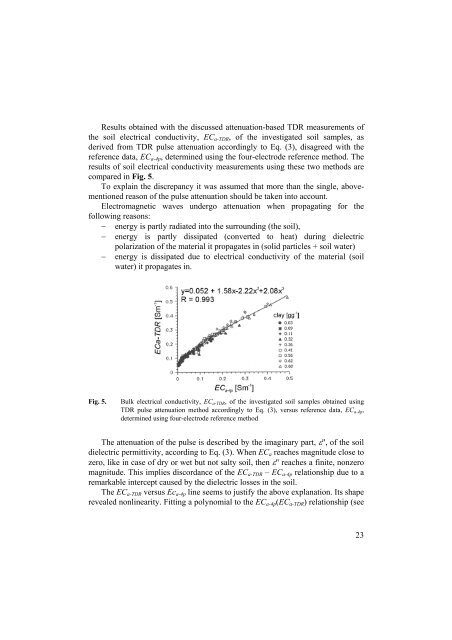ekS - Instytut Agrofizyki im. Bohdana DobrzaÅskiego PAN w Lublinie ...
ekS - Instytut Agrofizyki im. Bohdana DobrzaÅskiego PAN w Lublinie ...
ekS - Instytut Agrofizyki im. Bohdana DobrzaÅskiego PAN w Lublinie ...
You also want an ePaper? Increase the reach of your titles
YUMPU automatically turns print PDFs into web optimized ePapers that Google loves.
Results obtained with the discussed attenuation-based TDR measurements of<br />
the soil electrical conductivity, EC a-TDR , of the investigated soil samples, as<br />
derived from TDR pulse attenuation accordingly to Eq. (3), disagreed with the<br />
reference data, EC a-4p , determined using the four-electrode reference method. The<br />
results of soil electrical conductivity measurements using these two methods are<br />
compared in Fig. 5.<br />
To explain the discrepancy it was assumed that more than the single, abovementioned<br />
reason of the pulse attenuation should be taken into account.<br />
Electromagnetic waves undergo attenuation when propagating for the<br />
following reasons:<br />
− energy is partly radiated into the surrounding (the soil),<br />
− energy is partly dissipated (converted to heat) during dielectric<br />
polarization of the material it propagates in (solid particles + soil water)<br />
− energy is dissipated due to electrical conductivity of the material (soil<br />
water) it propagates in.<br />
Fig. 5.<br />
Bulk electrical conductivity, EC a-TDR , of the investigated soil samples obtained using<br />
TDR pulse attenuation method accordingly to Eq. (3), versus reference data, EC a-4p ,<br />
determined using four-electrode reference method<br />
The attenuation of the pulse is described by the <strong>im</strong>aginary part, ε", of the soil<br />
dielectric permittivity, according to Eq. (3). When EC a reaches magnitude close to<br />
zero, like in case of dry or wet but not salty soil, then ε" reaches a finite, nonzero<br />
magnitude. This <strong>im</strong>plies discordance of the EC a-TDR – EC a-4p relationship due to a<br />
remarkable intercept caused by the dielectric losses in the soil.<br />
The EC a-TDR versus Ec a-4p line seems to justify the above explanation. Its shape<br />
revealed nonlinearity. Fitting a polynomial to the EC a-4p (EC a-TDR ) relationship (see<br />
23
















